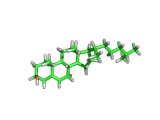Thu Dec 11 19:25:23 PST 2008
Bad Cholesterol

Cholesterol, the molecule above, is produced in large quantities (around a gram per day) by your body. In fact, cholesterol is essential for life. Cholesterol is the starting point of the formation of hormones such as testosterone and estrogen. Additionally, cholesterol is an important component of cell membranes and is found in the myelin insulation of nerve cells where it assists in the conduction of nerve impulses by providing an electrical barrier.
As the image above shows, cholesterol has a single hydroxyl (-OH) group and this hydrophilic group is not enough to render the molecule soluble in water or blood. Consequently, in the body, cholesterol is transported in the form of lipoprotein complexes, protein coated particles with insoluble molecules at their core. These lipoprotein complexes are characterized by their density, and empirically an association between low density lipoprotein (LDL) complexes and atherosclerosis, has led to the term 'bad cholesterol' being applied to an increase in LDL relative to HDL in the blood (where HDL is high density lipoprotein, of course).
So, as is often the case, the detail is more interesting than the simplification. Cholesterol is vital for the functioning of your nerves, endocrine system, and cell membranes, and 'bad cholesterol' is actually a measure of the relative concentrations of the different cholesterol transporting agents within your blood stream.
If you were to entirely eliminate cholesterol from your system undesirable and quite probably fatal consequences would ensue.
However, if you have too a high a ratio of LDL to HDL, your cholesterol is showing up in the form associated with heart disease and you would be well advised to pay attention and seek to adjust the ratio. Two well known means to effect such a change are exercise and statin drugs. Neither eliminates cholesterol. However, they do change the ratio for the better.